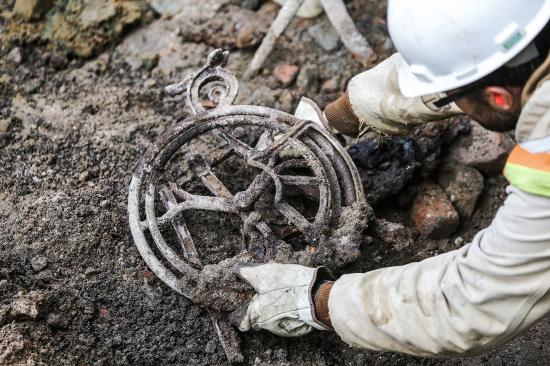Laura Dudnick
Source - http://www.sfexaminer.com/archaeologists-unearth-slice-of-pre-1906-earthquake-chinatown-amid-central-subway-construction/
 Sonoma State University staff archaeologist Kyle Rabellino recovers what looked to be old sewing machine parts and broken pottery from an excavation being done on Stockton Street in San Francisco's Chinatown Monday, Dec. 7, 2015. The artifacts were discovered while workers were digging during construction of the Central Subway. (Mike Koozmin/S.F. Examiner)
Sonoma State University staff archaeologist Kyle Rabellino recovers what looked to be old sewing machine parts and broken pottery from an excavation being done on Stockton Street in San Francisco's Chinatown Monday, Dec. 7, 2015. The artifacts were discovered while workers were digging during construction of the Central Subway. (Mike Koozmin/S.F. Examiner)
Residents and visitors of San Francisco’s eastern neighborhoods in recent years have likely witnessed the construction of the Central Subway, a $1.6 billion project that will ultimately link Chinatown and South of Market via a Muni light rail line for the first time.
But amid the ubiquitous work to make way for the new Muni line by 2019, crews have also been excavating for historical artifacts as part California’s environmental requirements of most new construction in The City.
While such an effort is not only mandated by state law, it’s also helping to reunite San Francisco with relics from its past not seen in over a century.
At the Central Subway construction site on Stockton Street between Jackson and Washington streets Monday, beneath the sidewalk in front of what is now the Chinese Americans Citizens Alliance building, archaeologists chipped away at bricks and dirt 8 feet below the street to uncover pieces of what turned out to be 19th century industrial sewing machines.
The sewing machines are believed to have been used in the basement of a Chinatown factory that likely either crumbed or burned down in the devastating 1906 earthquake and fire. Much like other artifacts from various eras uncovered during the excavation of construction sites, Monday’s discovery shed a unique light on life in Chinatown in the late 1800s.
“This is unprecedented in our experience,” said Adrian Praetzellis, director of the Anthropological Studies Center at Sonoma State University. “There’s very little that remains of Chinatown prior to the [1906] earthquake, so this is basically the last remains of the earliest Chinatown.”
The university is one of a half-dozen archaeological consultants hired by The City to excavate construction sites. After digging out the historical items, which will likely take several days, the Sonoma State archeology team will bring the sewing machine parts back to their lab and try to uncover the mystery of who used them and how they ended up beneath a Chinatown sidewalk.
Dana Shew, an oral historian and archaeologist at Sonoma State, plans to visit the national archives in San Bruno next week to study the merchant file for the site’s former address, 1018 Stockton St. Shew said she can potentially find the names of the men and women who used the sewing machines that have been buried beneath Chinatown for over a century.
While the sewing machines are a unique find for archeologists because of the era from which they were used, as well as the location where they were found, the discovery of historical objects in San Francisco is becoming increasingly common because of The City’s development boom.
“We have been so busy in The City for almost the last 10 years,” said Michael Stoyka, an archeological and bone specialist at Sonoma State. “A lot of this development leads to us being here.”
Archaeological studies of construction sites in The City have taken a new twist in the past decade as well with the creation of geographic information system (GIS) layers that align with a particular period of time. As of today, five layers have been developed since 2006: maritime resources, Chinese, prehistoric, the Spanish/Mexican period and the Yerba Buena period.
“There are future areas we’ll cover as well, like the Gold Rush period,” said Randall Dean, the Planning Department’s only full-time archaeologist. “The game plan is to work with additional ethnic groups [to develop] new layers.”
Allison Vanderslice, who splits her time between archaeology and preservation for the Planning Department, said the GIS layers are used to help determine whether a construction site requires further excavation for potential historic purposes. Projects that propose to dig to certain depths – 2 feet in some areas, 8 in others, for instance – automatically trigger sensitivity studies.
Much of the development today aligns with archaeologically sensitive areas, particularly in neighborhoods like Yerba Buena, South of Market, Mission Dolores, Mission Bay and the Bayview, said Sarah Jones, The City’s director of environmental planning.
“If you think about the history of San Francisco and all the things that have happened over time, it’s the same areas that keep seeing development and change over and over,” Jones said. “There’s a whole city underneath the ground that we can’t see, and we want to make sure we don’t lose that.”
And as the development boom continues to adorn The City with new skyscrapers, deeper excavation occurs, potentially drumming up slivers of history.
“What’s happening now is you’re having taller buildings, so our foundations are going deeper,” Vanderslice said. “You might have had multiple building episodes on one site over time, [but] what’s being built now is definitely going to take out the archaeological record as it goes down 20, 30, 40 feet sometimes.”
For the Sonoma State team, beaming Monday at the discovery of the rusty sewing machine pieces, the construction boom means more opportunities to dig for history – even though, at some point, there won’t be anything left to find.
“They’re not making archaeological sites anymore, so once development comes in and destroys a site it’s gone forever,” said Praetzellis, the Sonoma State professor. “At some point there’s going to be none left. With the rate of development in San Francisco, that’s not going to be far into the future.”